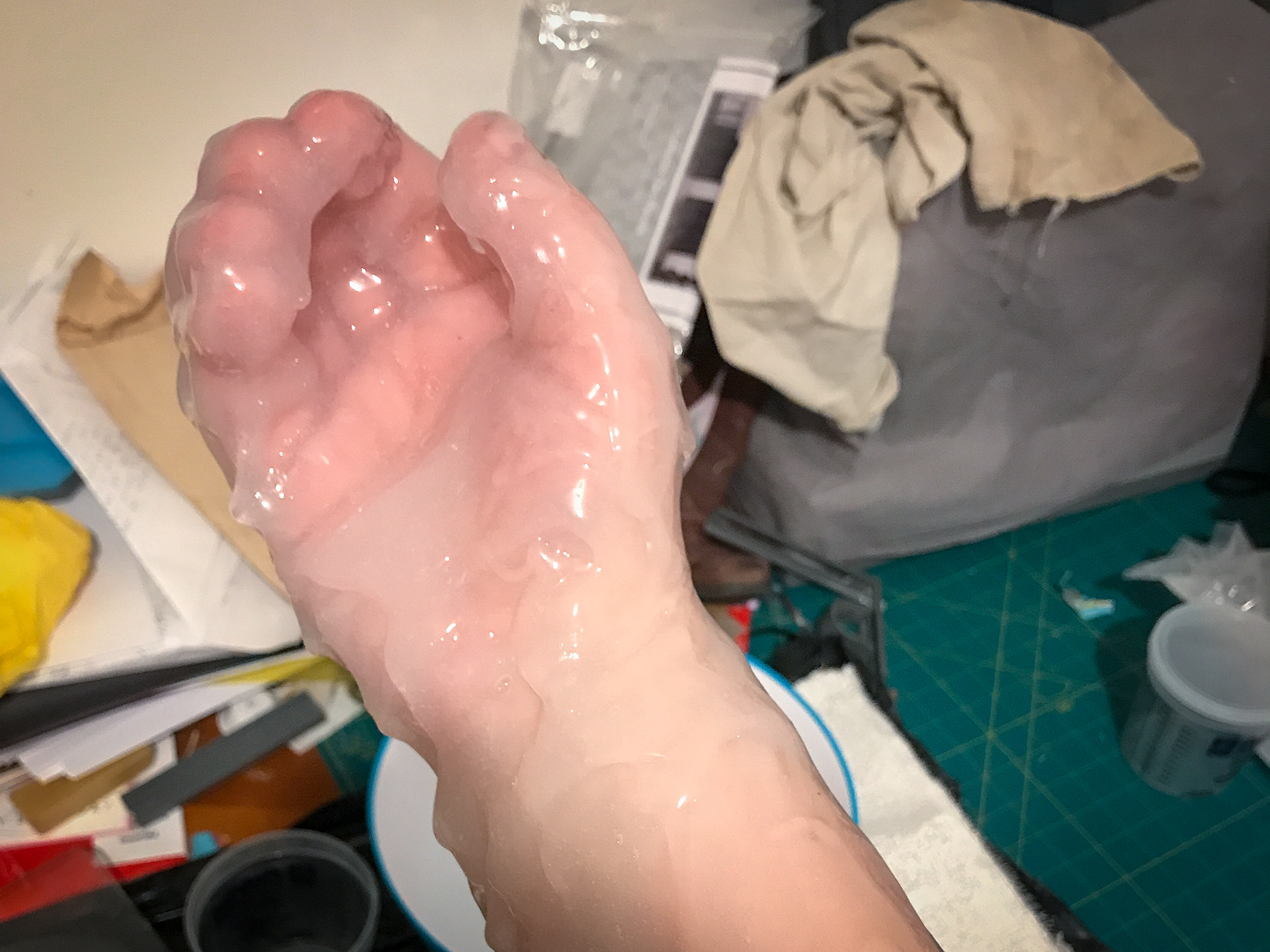The concept
Despite working with food and in restaurants for most of my life, from vegetable farms to sports bars to fine dining restaurants, I’ve always felt a level of discomfort in formal dining situations. In these spaces the act of eating—one of the most basic behaviours of any living organism—is harnessed to countless unspoken rules of etiquette. I always feel like I’m out of place, just one step away from a major social violation that I have no idea is there.
I’ve always loved making food for people I care about because it feels like giving a part of myself. I wanted to explore this idea literally in this piece. I decided to work with a mould of my own hand, which I’ve used to prepare countless meals. The primary material is pork aspic that I made using pigs’ feet (in a sense the closest approximation I could manage to an actual human hand).
The fact that I was able to recreate the setting of a “white tablecloth” restaurant inside my own messy apartment using just a pair of curtains and thrifted tableware feels reflective of the facade I put on myself in those environments.
On the one hand, I feel very at home in restaurants. As I previously mentioned, most of my working life has been linked to restaurants on some level, but even before I started working I always associated restaurants and meals with the most joyous reunions and celebrations I’ve had with friends and family. But on the other hand, there is an incredible divide between the experience of the diner in a restaurant to that of the workers. Both front and back of house work is notoriously stressful and rife with underpayment, exploitation, and toxic interpersonal dynamics.
While serving staff tend to hide it better during service than their counterparts in the kitchen, restaurant workers in general are some of the most chaotically delightful people I’ve ever met, which I mean as a sincere compliment. Even if they’ve left restaurant work, you can always recognize a fellow restaurant person. In my opinion, the best restaurants are places where the warmth and irreverence of restaurant workers is imbued into the dining environment.
However, it’s all too common that the dining experience isn’t dictated by the people creating it, but by archaic rules that emulate aristocratic dining tables of old. When consuming food with others, we allow our standards of acceptable behaviour to be set according to these standards, despite living lives completely unrecognizable to those who designed them. I’ve felt out of place in this type of environment even when sharing food I myself prepared.
A lifetime of this tension is enough to make a person snap, which is exactly what I gave myself permission to do in this piece. Instead of worrying about taking too large a mouthful and disturbing my dining companions, I allowed myself to attack my meal with total abandon, and to embrace the discomfort of the viewer instead of devoting all my energy to avoiding it.
Process
I began the process by making a silicone mould of my arm. This proved more challenging than I had anticipated at first, which is my own fault because OF COURSE it’s hard to work on my dominant arm without a helper. I did the majority of the mould in one go so I wouldn’t have to mix silicone one handed, and then once it had set and I could work freely I was able to patch the few gaps and thin spots that had occurred in difficult areas.
Applying the support cast was also very difficult one-handed. I ended up having to make a second one because the first didn’t hold together well.
While I initially experimented with (and got great results) using gelatine and fruit juice in a gummy candy style formulation, I realized that a thick aspic would be more thematically appropriate for the project, since it’s closer to what my own hands are made of. Aspic is a gelatinous relative of stock or bone broth—I made mine using pigs’ feet sourced from a local butcher.
After six hours on the stove and the addition of a nice mirepoix and seasoning for depth of flavour, I had a thick, rich stock that solidified into a firm gel as it cooled.


To add a layer of “realism” (or maybe just excitement) to the final structure, I embedded bones and gristle from the feet into the arm. I also created a pocket of “blood” that would burst when it was split open. I made a thick coulis by stewing and straining fresh cranberries and froze it into narrow tubes that could also be embedded in the aspic. I realized in my tests that the coulis would start to be absorbed over time if it was left in the aspic, so I poured the cast with a spacer to create a gap where I could add the coulis and cap it with a final thin layer of more aspic just before use.
The hand came out of the mould very well, but unfortunately the fingers broke as I plated it. I will probably make further explorations using reinforcements in future.